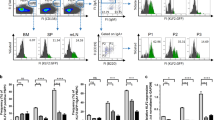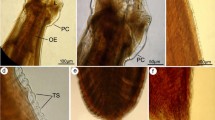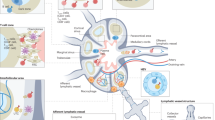Abstract
STUDIES on the induction of antibody production have shown that subcutaneously injected immunogens can be processed in two ways by draining lymph nodes1. Most of the immunogen retained in the node is actively phagocytosed by the macrophages of the sinuses of the medulla, while a smaller portion becomes attached to the surfaces of dendritic cellular processes iri the primary follicles of the cortex1–5. This latter phenomenon seems to be important because germinal centres subsequently form in immediate relation to this surface-retained immunogen1–5. Because the ability of follicular cells to capture immunogens is decreased in tolerant animals and increased in actively or passively immunized animals6–8, it may be that opsonins, specific or non-specific, are required for follicular localization of immunogens and thus for the formation of germinal centres in lymph nodes. To test this hypothesis further we have compared the degree of follicular localization of flagella of Salmonella adelaide labelled with iodine-125 in germ-free rats and in conventionally raised rats, assuming that germ-free rats would have experienced less exposure to antigens which might have induced cross-reacting or non-specific opsonins.
This is a preview of subscription content, access via your institution
Access options
Subscribe to this journal
Receive 51 print issues and online access
$199.00 per year
only $3.90 per issue
Buy this article
- Purchase on SpringerLink
- Instant access to full article PDF
Prices may be subject to local taxes which are calculated during checkout
Similar content being viewed by others
References
White, R. G., The Immunologically Competent Cell: Its Nature and Origin, Ciba Found. Study Group No. 16 (edit. by Wolstenholme, G. E. W., and Knight, J.), 6 (Churchill, London, 1963).
Nossal, G. J. V., Ada, G. L., and Austin, C. M., Austral. J. Exp. Biol., 42, 311 (1964).
Miller, J. J., and Nossal, G. J. V., J. Exp. Med., 120, 1075 (1965).
Mitchell, J., and Abbot, A., Nature, 208, 500 (1965).
McDevitt, H. O., Askonas, B. A., Humphrey, J. H., Schechter, I., and Sela, M., Immunology, 11, 337 (1966).
Humphrey, J. H., and Frank, M. M., Immunology, 13, 87 (1967).
Ada, G. L., and Lang, P. G., Immunology, 10, 431 (1966).
Lang, P. G., and Ada, G. L., Immunology, 13, 523 (1967).
Ada, G. L., Nossal, G. J. V., and Pye, J., Austral. J. Exp. Biol., 42, 295 (1964).
Williams, G. M., Immunology, 11, 467 (1966).
Nossal, G. J. V., Immunology, 2, 137 (1959).
Nossal, G. J. V., Ada, G. L., and Austin, C. M., Austral. J. Exp. Biol., 42, 283 (1964).
Author information
Authors and Affiliations
Rights and permissions
About this article
Cite this article
MILLER, J., JOHNSEN, D. & ADA, G. Differences in Localization of Salmonella Flagella in Lymph Node Follicles of Germ-free and Conventional Rats. Nature 217, 1059–1061 (1968). https://doi.org/10.1038/2171059a0
Received:
Issue date:
DOI: https://doi.org/10.1038/2171059a0
This article is cited by
-
A chemokine-driven positive feedback loop organizes lymphoid follicles
Nature (2000)
-
Gnotobiological models and methods in Immunology
Folia Microbiologica (1979)
-
Die Antigen-Eliminationstechnik beim Hund
Zeitschrift für Die Gesamte Experimentelle Medizin einschließlich experimentelle Chirurgie (1971)



